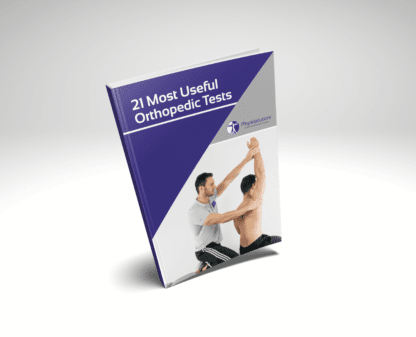Strength Training for Knee OA vs Attention Control

Introduction
Osteoarthritis (OA) is the most common form of arthritis in the body. Knee OA affects more than 250 million people worldwide. Clinical practice guidelines recommend strength training, however, most RCTs investigating this modality do not match the recommended intensity. The trials use lower — or don’t even measure — percentages of one repetition maximum (1RM) and generally lasting between 6 and 24 weeks, which might be too short.
Hypotheses exist on strength training reducing compressive forces in the knee due to increased shock absorption capabilities of the surrounding muscles. This preregistered trial aims to investigate the aforementioned mechanism, combined with the potential therapeutic effect.
Methods
Included patients were ambulatory community-dwelling adults of 50 years and older. They presented with mild to moderate radiographic medial tibiofemoral OA in at least one knee associated with patellofemoral (PF) osteoarthritis (none to moderate). The knees had to be mechanically aligned according to specific degrees in joint alignment and BMI needed to range somewhere between 20 and 45. Participants had no formal strength training interaction in the last 6 months.
Patients were excluded in case of severe PF joint OA or lateral more than medial OA. Adding to this, a Montreal Cognitive Assessment score of less than 20 induced exclusion as well.
A priori power calculations were made to ensure 80% power to detect a between-group difference of 1.1 on pain or 316 Newton force for the primary outcome measures, being the WOMAC for pain (20 point scale) and knee joint compression forces during walking, respectively. Multiple secondary outcome measures were investigated. However, these were exploratory due to the lack of power and will not be discussed.
Lower body exercises:
Hip abduction and adduction, leg curl, leg extension, leg press, seated calf raises
Upper body exercises:
Compound row, vertical chest, lower back, and abdomen
Some of these might be a bit confusing and unclear which exercise they actually meant. However, the authors did not go into further detail in their protocol and published paper.
The exercise program was as follows:

Total workload was equated between groups (weight*reps*sets*frequency).
The strength training interventions continued for 18 months.
The attention control group received biweekly healthy living workshops for 6 months and once a month thereafter. They were asked to complete homework, review topics, and engage in small group discussions to increase their involvement in this study arm.
Results
Among the 377 randomized patients, no statistical differences for WOMAC pain or compression forces at 18 months were found between the high-intensity, low-intensity, and attention control groups. All groups got equally better, about 2-3 points on the 20-point WOMAC scale starting at around 7/20.
Questions and thoughts
Here’s a real kick in the bias. We cannot hide the fact that we’re pretty surprised about these results. I think most of us could imagine the possibility of no difference between high and low intensity. However, no differences compared to attention control sting a bit. How is this possible? Is strength training no better than placebo, regression to the mean, and/or natural history?
You might ask yourself why the authors included upper body exercises. This is probably to promote a potential systemic effect of exercise on arthritis in general. To be fair, we don’t know if we need to be specific to the affected body part. This hasn’t been tested yet. One comment you could make about the exercises is the lack of lower body compound exercises. I’m not the first one to be screaming that every exercise needs to be ‘functional’ — whatever that means. However, multi-joint exercises such as lunges, squats, deadlifts, etc. might alter results.
One thing worth noting is the fact that the control group got 33% better which is quite a lot of attention. I think most physiotherapists wouldn’t feel really comfortable just talking to their patients to ‘treat’ their knee OA.
Does this mean we shouldn’t do a thing? Probably not. Maybe this is just more evidence that your patients need a plan and something to work for. Maybe it’s not so much about the specifics of your intervention but rather the commitment.
Talk nerdy to me
This will be a pretty short walkthrough since this was an excellent study. Their question was specified and answered (you’d say that’s the very least, but it’s often not the case), their methodology was of high quality, the stats were rigorously controlled and they even noted their secondary outcomes are exploratory. Why is this the case? The more data you collect, the higher the chance of false positives coming through. This is called the multiple comparison problem. They corrected these errors with a Bonferroni correction for their primary outcomes which lowered their significance threshold to 0.0083.
The trial was preregistered which means the researchers would get caught if they swapped outcome measures for significance or tried different types of analyses to p-hack. That’s the significance of a preregistered trial. As the wise Ronald Coase once said: “If you torture the data long enough, it will confess to anything.”.
Overall we should be happy to have such high-quality studies, even when they don’t support our bias. That’s science.
Take Home Messages
- No difference between HIT, MIT, and attention control for knee OA
- Setting goals and working toward them with your patient is possibly the most important thing
- A very strong trial that contradicts many expectations
Reference
21 OF THE MOST USEFUL ORTHOPAEDIC TESTS IN CLINICAL PRACTICE
We have comprised a 100% Free E-Book containing 21 of the hands-down most useful orthopedic tests per body region guaranteed to help you reach a proper diagnosis today!



